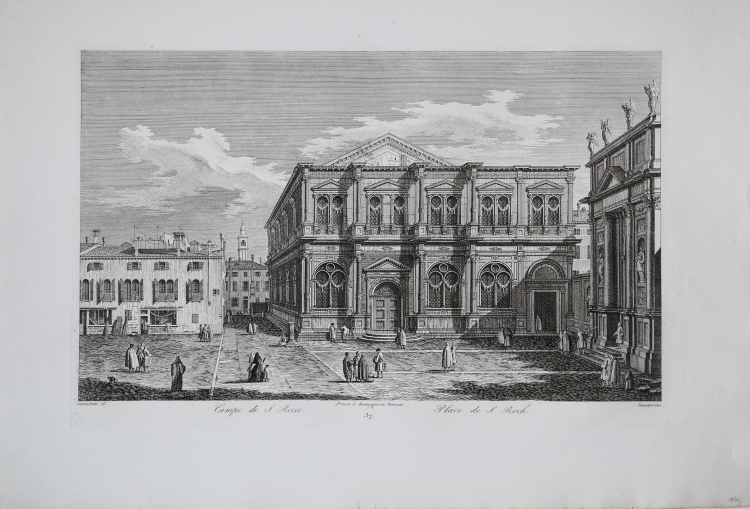


| Reference: | S37825 |
| Author | Antonio Visentini |
| Year: | 1742 ca. |
| Zone: | Venice - Campo di San Rocco |
| Printed: | Venice |
| Measures: | 430 x 275 mm |


| Reference: | S37825 |
| Author | Antonio Visentini |
| Year: | 1742 ca. |
| Zone: | Venice - Campo di San Rocco |
| Printed: | Venice |
| Measures: | 430 x 275 mm |
Copper engraving taken from Urbis Venetiarum prospectus celebriores ex Antonii Canal tabulis XXXVIII [...], whose first edition was published in 1742, then reprinted several times during the century by Furlanetto and Viero as well as by Battaggia in the nineteenth century.
Engraved by Antonio Visentini after Canaletto, printed by Battaggia.
Excellent example.
|
Antonio Visentini (21 November 1688 – 26 June 1782) was an Italian architectural designer, painter and engraver, known for his architectural fantasies and capricci, the author of treatises on perspective and a professor at the Venetian Academy. Born in Venice, Visentini was a pupil of the widely travelled Baroque painter Giovanni Antonio Pellegrini,[1] who had painted some decors in English country houses at the beginning of the 18th century. Visentini is best known today as the engraver for Canaletto's first great series of Venetian vedute published under the title Urbis Venetiarum Prospectus Celebriores ex Antonii Canal,[2] organised by British resident Joseph (Consul) Smith (1682–1770). The series was begun around 1728 and by the time it was completed in 1735, thirty-eight etchings and engravings had been printed.
On the Grand Canal, Visentini was commissioned to redesign the façade of the residence of Consul Smith, the Palazzo Balbi. He collaborated with Francesco Zuccarelli on capriccios based on English Palladian villas, again for Consul Smith;[3] some have passed with Smith's collection to the British Royal Collection. In Vicenza, Visentini painted frescoes at the Villa Valmarana, for which Gian Domenico Tiepolo painted the figures. In the 1760s the English architect James Wyatt studied with him as an architectural draughtsman and painter.
Visentini's work, the Osservazioni,[4] published in Venice in 1771, was intended as a complement and an extension of a treatise by Teofilo Gallacini (1564–1641), which concerned itself with the errors of Mannerist and early Baroque architecture.[5] Visentini's engravings in the Osservazioni illustrate his proposed modifications correcting Baroque architectural details.
Visentini taught at the Accademia di Belle Arti in Venice from 1772–78, and he died in Venice in 1782.
|
|
Antonio Visentini (21 November 1688 – 26 June 1782) was an Italian architectural designer, painter and engraver, known for his architectural fantasies and capricci, the author of treatises on perspective and a professor at the Venetian Academy. Born in Venice, Visentini was a pupil of the widely travelled Baroque painter Giovanni Antonio Pellegrini,[1] who had painted some decors in English country houses at the beginning of the 18th century. Visentini is best known today as the engraver for Canaletto's first great series of Venetian vedute published under the title Urbis Venetiarum Prospectus Celebriores ex Antonii Canal,[2] organised by British resident Joseph (Consul) Smith (1682–1770). The series was begun around 1728 and by the time it was completed in 1735, thirty-eight etchings and engravings had been printed.
On the Grand Canal, Visentini was commissioned to redesign the façade of the residence of Consul Smith, the Palazzo Balbi. He collaborated with Francesco Zuccarelli on capriccios based on English Palladian villas, again for Consul Smith;[3] some have passed with Smith's collection to the British Royal Collection. In Vicenza, Visentini painted frescoes at the Villa Valmarana, for which Gian Domenico Tiepolo painted the figures. In the 1760s the English architect James Wyatt studied with him as an architectural draughtsman and painter.
Visentini's work, the Osservazioni,[4] published in Venice in 1771, was intended as a complement and an extension of a treatise by Teofilo Gallacini (1564–1641), which concerned itself with the errors of Mannerist and early Baroque architecture.[5] Visentini's engravings in the Osservazioni illustrate his proposed modifications correcting Baroque architectural details.
Visentini taught at the Accademia di Belle Arti in Venice from 1772–78, and he died in Venice in 1782.
|